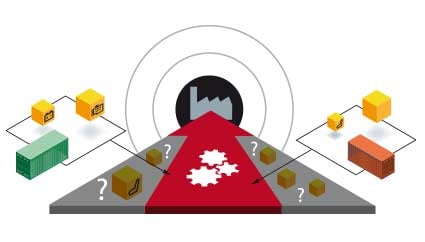Your Blind Spot: Value Stream Planning for Every Part
Nick Ostdick - May 10, 2016

 A blind spot - every car has one.
A blind spot - every car has one.
You’re driving down the interstate and when you attempt to change lanes, a car has slipped into your blind spot and you nearly cause an accident because you don’t have the visibility necessary to execute a proper lane change. It’s a frustrating, potentially hazardous scenario that’s analogous to what many companies experience when attempting to apply lean principles to their supply chain logistics and management, particularly when it comes to the notion of value stream planning for every part.
We recently discussed in a previous entry the importance of PFEP (planning for every part) strategy and how the ability to know the location, status, inventory level, and other critical factors is a key driver in increasing production efficiency and creating insights into the capacities of each facility to fulfill orders and deal with changes in production specifications and constraints.
Value stream PFEP, or optimization your PFEP strategy and solution, takes this all important concept one step further in breaking down the assignment of parts and part families throughout the entire value chain to enhance production and transportation efficiency and identify and eliminate areas of waste within the supply stream.
The trouble is, like a car on the interstate, value stream PFEP often falls into a company’s blind spot, making it difficult to navigate the increasing complexities of the global production and supply roadway.
The Problem with Value Stream PFEP
While the definition of value stream PFEP might be simple enough to grasp, its application - or lack thereof - can be somewhat tricky to understand or realize. What’s more, many companies do not fully comprehend it as a value-added process for leveraging a lean supply chain strategy.
Part of the issue resides with the fact that once value stream assignments are implemented - part or part families are assigned based on production levels, product lifecycles, facility capacities, and other factors - companies don’t evaluate the results of these assignments on a regular basis, or in some cases lack the necessary metrics to conduct a thorough analysis of these assignments - hence our blind spot.
There are so many constantly shifting variables within the supply stream: volume changes; order alterations; delivery frequency; supplier changes; transportation costs; and other cost factors related to production facility capacity, distributor capacity, and even personnel levels. Because of these changes, supply planners and managers must be constantly vigilant of their value stream PFEP and how these variables impact their value stream strategy.
Without evaluation, analysis, reassignment, and replanning, any potential savings or increase efficiency across the entire value chain is lost, and companies will continue to hemorrhage resources and capital and will be handcuffed in terms of pinpointing and eliminating areas of waste.
How to Leverage Value Stream PFEP
Leveraging value stream PFEP requires a close architectural examination of a company’s entire manufacturing and supply network to identify the possible value stream types and classifications for each combination of the supplier-plant relationship - value stream PFEP is not a one-size-fits-all hat, and there are numerous classifications for each supplier-plant relationship based on production and transportation efficiency and cost.
First, planners and managers must define the various cost factors for part or production inventory and transportation - the cost of direct routes versus alternative routes, method of transportation, dock/warehouse capacity, volumes per supplier, and so on.
Once these decisions have been made, planners can then address part and part family segmentation to create a best-practice strategy for transportation planning and product movement. The clustering of part and part families based on relevant production and transportation needs takes into account a number of factors including frequency, demand volumes, part value, and others, which then allows for planners and managers to assign each part/part family to a corresponding value stream based on the supplier-plant relationship.
As we discussed earlier, constant vigilance and analysis of these assignments - and the agility and transparency to make corrections or alterations - is a core driver in the value proposition of value stream PFEP. To conduct this analysis, planners and mangers must evaluate such factors as demand and delivery windows and frequencies; volume forecasts and modeling; fluctuations in inventory and transportation costs and the balance thereof; and the overall value stream classification.
Benefits of Value Stream PFEP
For companies that can successfully leverage a value stream PFEP strategy, the overall benefit is a leaner production and supply stream that enhances a company’s ability to compete in today’s global supply network and drives growth and productivity in a variant-rich industry. But on a more micro-level, incorporating a value stream PFEP solution provides companies with:
- Lean supply of purchased parts - Part overages or shortages can create significant production and delivery delays, and these bottlenecks can create a domino effect throughout a company’s entire value chain. Because value stream PFEP enhances visibility and agility, companies can see and review in real-time inventory of necessary parts to create and maintain accurate production schedules.
- Reduction in transportation costs - Because current inventory of parts or products, their location, status, and destination or allocation for orders is accessible by the key players in a company’s supply network, transportation costs can be significantly reduced by leveraging best practices for efficiency when it comes to fill-rates for containers, product movement between facilities, transportation routes, and delivery to the customer.
- Proper balance of inventory vs. transportation costs - Creating the right balance between inventory and transportation costs is vital in maintaining a lean, cost-effective supply stream. Because value stream PFEP provides insight into a company’s inventory and warehouse holdings and the relationship between warehousing and the movement of products, planners and managers can executive value-added inventory purchasing and transportation strategies to ensure the right parts arrive at the facility in the most economical way possible.
LATEST POSTS
- Understand Circular Economy in The Manufacturing Industry
- How Can Industry 4.0 IT Integration Be Achieved Smoothly?
- The Significance of Order Sequencing in Discrete Manufacturing
- How to improve your Supply Chain Management: The Power of Control Towers
- Optimizing Human Resource Scheduling in Manufacturing: A Technological Approach



